Rick Wayne's Blog, page 15
August 23, 2020
(Art) The High-Color Fantasy of Anato Finnstark

Freelance artist Anato Finnstark has a kind of refined speed-painting style. It doesn’t look like speed painting because of his inspired use of bright colors to create the focal point. By capturing the reader’s eye and holding it at the point of action, we don’t realize the rest of the space actually fades to a blur or repeats a simple brush stroke, without the same level of detail as the visual center. Still, the result is stunning.
Find more by the artist on his ArtStation page.
[image error][image error][image error][image error][image error][image error][image error][image error][image error][image error][image error][image error][image error][image error][image error][image error][image error][image error][image error][image error][image error][image error][image error][image error][image error][image error][image error][image error][image error][image error][image error][image error]
August 20, 2020
Killer Robots
The fear of robots has been there from the beginning — where I’m including creations like Frankenstein. At a mythological level, robots are our dark reflection. (They often look like us.) They instantiate our creeping fear that our own technology will rise up to destroy us.

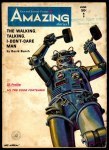
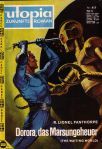
That destruction need not be malevolent. We may simply become obsolete. In that sense, Blade Runner and the ballad of John Henry are much closer than they might appear.
[image error]
It’s isn’t that there’s no cause for concern. Still, I find it very odd that we’re more worried about murderous machines than the murderous apes that build/wield them, a distinction writers like Isaac Asimov and Arthur C. Clarke understood. In “2001,” HAL kills not because he’s evil but because he’s given secret paranoid instructions from the military.
Some people are terrified at the prospect of killer robots, but consider: if we must war — if it’s inevitable — then I’d rather a proxy one, where armies of weaponized roombas slaughter each other on our behalf. The best defense against killer robots might be… robot-killing robots, which require them to possess the same skills.

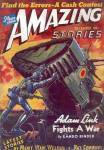
The question with all of these technologies, from nuclear weapons to nanotech, is how you stop them once they become not merely feasible but cheap. Even with a legal moratorium, there is still a strong incentive to cheat, if only out of suspicion that your enemy is — or might be.
Even so, they are all just tools. I can use a baseball bat to play ball with my nephew or to beat his head in. The difference of course is that, having beat his head in, the baseball bat doesn’t go on to beat everyone’s head in.
[image error]
Technology has become an existential threat. That is not unique to robots (or AI). In all scenarios, I’m still much more worried about what the humans will do with the machines than what the machines will do on their own.
August 18, 2020
August 17, 2020
(Art) The Abandoned Megacities of Paul Chadeisson
[image error]
It’s hard not to read the work of freelance VFX artist Paul Chadeisson as a statement on climate change and civilizational collapse. But far from feeling preachy, his haunting megastructures inspire reflections of the deep future, both fantastic and mundane.
Find more by the artist on his ArtStation page.









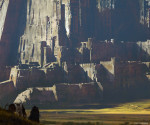
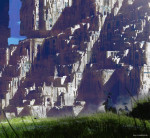
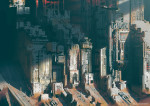











August 16, 2020
Waves of Creativity Unto Death
Hokusai didn’t produce his internationally-recognized masterpiece “Great Wave Off Kanagawa” until he was in his 70s. You can track the evolution of the composition in the images below, which were created in 1797, 1803, 1805, and 1826-33, respectively — meaning the artist was in his middle 30s when he made the first, on either side of 40 for the next two, and in his 70s for the last.
[image error] [image error] [image error] [image error]
These days, we want everything to be measurable. That is, we want instant gratification. If I practice poetry or a musical instrument for three months, I expect to get better. If I can’t see improvement, if I can’t measure it, I conclude I must have no “talent” and give up — because only those things you are “good enough” make money at are worth pursuing (a lie) and anybody who was ever good at something was good at it from birth (also a lie).
Imagine if we expected love to work that way, to have only commercial value and to rise linearly in proportion to time. There is some correlation between affection and time of course, but much like the chicken and the egg, it’s hard to define which comes first and which comes after. We don’t generally spend time with people we don’t like on the hope that it might change our minds.
Bill Murray captured this when noticing how odd friendship is. We go through life meeting all kinds of people, but every now and then for some reason we say “Yeah, I like this one” and then you end up doing stuff together.
Very few friendships, and almost no romantic relationships, proceed without trouble. Few us are born with an innate talent for them. They’re prickly fruits. They take work and experience to cultivate. Sometimes one goes backward before going forward.
Many artists experience a similar “flowering” in their work. For whatever reason, at some point something changes and they begin producing works of much greater beauty than they had in the past. (The reverse is also true.)
Hokusai dedicated himself to his craft. He practiced it his entire life. But not because he knew he knew at 33 that he would create a masterpiece at 70. How could he? But he still got up every day and practiced.
The rewards of dedication, especially to artistic endeavor, don’t grow linearly. They aren’t discrete, atomic, measurable. There is no calculus that says you are or are not wasting your time in pursuit of some craft. Wasting it by what measure? How much money it puts in your pocket?
It’s not that you should pursue art that doesn’t make money. It’s the the question of money is irrelevant. We should each have in our lives something that grows our soul. Of course, once we dedicate to it, we’ll want to create a masterpiece. Few of us will ever will. (That is true by definition.) If that’s why we do it — in other words, if knowing that would never happen means we would stop — then we’re probably going to fail, not just at creating a masterpiece, but at getting anything out of it at all.
It’s like trying to love your spouse’s flaws away. I love my wife inclusive of her flaws, nor did I marry her because she made a lot of money or ranked high on some objective measure of spousehood. It isn’t just that she means more to me than my job; it’s that she enriches my life more than any job ever could.
Your genes have you obsessed with status. They want you to increase your sexual circle so that you can make more copies of them. They want you to be popular, and they promise you it will feel amazing. But will it?
A few years ago, scientists asked a group of 100-year-olds about life and regret. Not one of them said “I wish I would’ve spent more time at the office” or “I wish I would’ve made more cash.” Not one. Any regrets they had seemed to be the exact opposite: spending more time with family, traveling, learning a musical instrument.
If we replicate that study in 80 years time, I doubt any of us will say “I wish I would’ve spent more time on social media” or “I wish I would’ve pimped my album more.” If that is the measure, then had Hokusai died at 69, a year before his masterpiece, we would’ve laughed and called him a tool.
(Art) The Vibrant Fantasy of Sarunas Macijauskas
[image error]
The paintings of Lithuanian artist Sarunas Macijauskas are just effing stunning, with killer usesof color and negative space. Note in his painting “Surgeon” how a spotless white carapace replicates the white coats of doctors, but there’s a blood-red visor and a dark, almost sinister machinery peeking out from underneath — or his white walker, which uses a limited black-and-teal palette to create a literal and figurative chill — or the pale pastels of the warlock’s astral bird, which, coupled with its enormous size, makes it appear both vibrant and ethereal.
Find more by the artist on his ArtStation page.
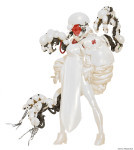
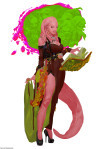
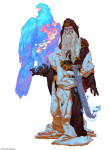
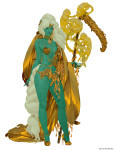
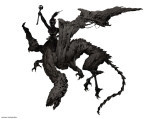
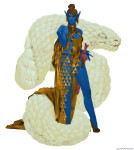

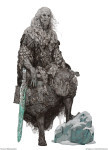

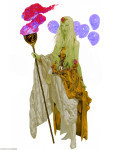
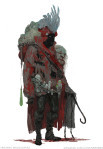
August 14, 2020
(Art) The Vibrant Fantasy of Sarunas Macijauskas
[image error]
The paintings of Lithuanian artist Sarunas Macijauskas are just effing stunning, with killer usesof color and negative space. Note in his painting “Surgeon” how a spotless white carapace replicates the white coats of doctors, but there’s a blood-red visor and a dark, almost sinister machinery peeking out from underneath — or his white walker, which uses a limited black-and-teal palette to create a literal and figurative chill — or the pale pastels of the warlock’s astral bird, which, coupled with its enormous size, makes it appear both vibrant and ethereal.
Find more by the artist on his ArtStation page.











August 12, 2020
(Fiction) Symphony and Fugue
It was as if we walked for hours through someone’s dark and anxious dreams. He navigated it as only a spiritwalker can, a man trained since birth not only to battle evil spirits but also to retrieve the lost souls of the sick. We emerged some time later in a church somewhere in Italy. We gave the parish priest quite a fright as we stepped from the gap in a marble ensconcement at the back of the sepulcher. The clock tower in the square outside made it clear we had covered not only distance but time. It was then several hours earlier than when we had left. It was odd, I remarked, to think that right then, the two of us were also standing in the grand hall before the High Arcane. Could we not go and alter events? But he said no, that no matter which path we took from that church—train, automobile, helicopter—we would not be able to reach the Keep of Solomon one moment before we left, and so the paradox was always avoided.
“Such is the shape of space-time,” he said.
An older gentleman, a head shorter than me with long sideburns and a derby hat, shuffled by and made a face at our clothes, and again at Etude’s bare feet.
“I have heard that time is also money,” I said. “Perhaps you could find a way to render it so.” I lifted the legs of my cotton pants. “We need new clothes. We look like cultists in these outfits. Someone is bound to call the police.”
“Really?” he asked, looking down at his shirt. “I rather liked them.”
By means of a metal plaque at the door of the church, we discovered we were in Bergamo, in the foothills of the Alps. Like most Italian towns, its three- and four-story buildings were all of a similar design, and they lined the cobbled streets on both sides without gaps, as if forming the walls of a maze whose paths were never straight. Every avenue bent slightly and at odd times, seemingly for no reason other than to make sure you never quite knew where you were. It was a world unto itself and made to be so. It existed for the people who lived there and no one else. We found a quiet nook off a blind alley, too narrow for cars to pass, and sat under a cluster of hanging potted plants contemplating our options.
After a brief meditation, Etude raised his hands. Nothing happened at first, but before I could inquire as to his intentions, a rat appeared. It did nothing at first, as if it were afraid to approach. When a pair of pigeons landed nearby, the rat dares approach. It was followed in turn by all the animals of the city, not just rats and pigeons but kestrels, blackbirds, red foxes, bright finches, mouse-sized bats, feral cats—even wall-climbing lizards and a handful of frogs who hopped out of the gutter or from the mouths of dark pipes that fell from the rooftops. He asked them if they knew of the shiny metals and bits of paper that the humans traded, and they said yes. He asked if they might bring them, and they agreed. They seemed quite eager, in fact, for no one had bothered to talk to them in a very long time.
A brown rat the size of a small dog was the first to return. It walked headfirst down a vertical drain pipe carrying something in its teeth. It dropped it on the ground near Etude’s bare feet. It was a silver ring, quite large and heavily tarnished, with swirling bands at the top that held in place a sapphire of at least ten karats. Etude bowed to the rat and introduced himself and me. The rat was a kind of wise man and he told my friend he had come as soon as he heard, for it was rare anymore for people to honor the old ways—the ways before cities and towns. He said that under this city many babies were starving, and Etude promised to knock over a rubbish bin near the river, which he did on our departure. The wise rat thanked him and left.
On and on it went. An animal appeared bearing a small treasure, something lost in the cracks and sewers, and asked a favor of the shaman, which he happily obliged. Most were quite simple. A kestrel had some plastic netting wrapped around its feet and tail and asked that it be removed, which I was happy to do. She left us a single diamond earring. A mother cat with Gucci collar brought a snarling kitten, a child from a recent litter—a matted, angry little menace of a cub that her owners had discarded. The mother had rescued it and kept it in secret, but it bit her and refused to eat. The young shaman wasted not a moment. He lifted the tiny terror by the scruff of its neck. It hissed and tried to bite him, but he merely moved his hands over it and spoke in a low voice. Even animals can be possessed, it seems. When the spirit was mesmerized, Etude passed his hand through the kitten’s body and brought it out in a closed fist. He whispered words to his fingers, then opened them and blew, and black ash scattered on the breeze. He returned the tiny kitten, now mewing plaintively to its mother, whose gave us her owner’s gold money clip, stuffed with neatly folded bills—so many, they could not be easily counted.
Before long, there was a line of animals stretching around the corner, and I felt like Etude and I were royalty, receiving gifts and entreaties from our noble subjects. We were polite to them, and they were polite to us. There was much bowing and speaking of ancient oaths. Soon, as word spread to the wilds that a true shaman had appeared in the city, all semblance of order was dropped. As their numbers grew, the animals took to frenzy, agitated to excitement by the mere chance to see the strange bald man who remembered the ancient treaties, when men and beasts had warred and then made a pact. Birds of all stripes and colors swooped into the alley and dropped prizes. Bullfrogs croaked and hopped laboriously forward amid a tangle of rats and mice and more than a few voles who scurried so quickly that it was very hard to see them. Each deposited before the feet of the shaman the shiny detritus of the city—metals and papers and strange cut rocks.
As the animals swarmed, the pile at Etude’s feet grew, and he raised his arms in thanks. And so he stood amid the chaos, hands high, like the barefoot conductor of a great pastoral symphony. And then, just like that, it was done. Etude brought his hands down and the animals scurried away in all directions, as if they forgot that they could speak, and we were alone.
The pile we had amassed was mesmerizing. There were rings, bracelets, necklaces, loose gems and pearls, earrings, cash, and coins. Quite a bit of the jewelry was costume, of course, and amid the coins, I found several bottle caps, a penny slug, and some brass tokens to various laundromats and arcades. There was also a dog’s tag, three key chains (two with keys attached), and a ring fashioned from a nail. The birds had snagged a handful of restaurant receipts, presumably mistaking them for cash, including one bearing a freshly written phone number next to a hand-drawn heart. They had also pilfered someone’s grocery list and part of a newspaper crossword puzzle, all in Italian.
Even still, by the time the symphony reached its sudden climax, enough valuables had been delivered to fill a small chest. It was a genuine treasure. I had never seen a treasure before. Etude knelt and thrust a hand into it and lifted a full fist. Gold fell from between his fingers and clinked on the cobblestones.
“Will this do?” he asked.
I nodded meekly.
from the conclusion of my epic urban fantasy FEAST OF SHADOWS.
August 11, 2020
(Art) The Cinematic Sci-fi of Friendly Robot
[image error]
The work of French artist François Leroy, AKA Friendly Robot, looks like keyframes from some of the most awesome sci-fi movies never made, including several from the Star Wars universe.
Find more by the artist on his ArtStation page.










August 9, 2020
(Fiction) Harrowood House
I opened my eyes and the past faded. I took a long breath and let it out. Back to the present. Back to work.
I lifted myself up from the antique porcelain embalmer’s slab that held me. I was in the basement workroom of a house I knew well, although I hadn’t been there in many years. Not that it had changed, not in an age. The scuffed and comfortably worn cabinetry looked to be from the 1930s. The walls were papered in faded scenes from the Gay Nineties, including a bespectacled man with perfect posture riding a penny-farthing. The high-wheeled bicycle fad had actually died earlier, around 1880, but the nostalgia of the next generation lumped everything from that time together into a stiff-collared Frankenstein of uprightness. Next to the porcelain slab, a neatly folded pile of clothes waited for me on a stool: high-waisted mom jeans, brown-and-gold argyle socks, a 1990s Disney princesses T-shirt, and a red sweater. Resting on top was a handwritten note:
Welcome back! Wasn ’t sure when you would rise. Wake us at any hour. -A
Padded house slippers sat by the stairs like a loyal dog. After dressing, I stepped into them and listened. The house above was dark and quiet. But then, I was fairly certain it was the middle of the night. I had died sometime after three in the morning on Sunday, which meant it was within a few hours of that, either way, on the following Tuesday. I walked up the steps, two of which creaked softly, and stepped through the door, which had been left open. Beyond it was the ground-floor hallway of Harrowood House, a curiosity in dark-stained oak.
Except for the addition of quite a few potted plants, hanging and resting atop metal stands, it looked exactly as I remembered. Sepia-hued photos lining the staircase recounted the history of the house and its occupants. The Hywrod family, as they were then known, came from Wales, where they had lived since Celtic times. They moved to America when it was still a colony of the English and occupied a vacant farmhouse near the Chesapeake near the town of St. Michaels, whose peculiar church had been consecrated half a century earlier, in 1677, by the first wave of English settlers. Death stalked the colonies in those days, and within a few vibrant generations, the Harrowoods, as they became, secured a reputation and a small fortune, both of which had since faded. When the old stone farmhouse burned some years later, it only seemed appropriate to replace it with something grander.
The house whose steps I ascended was a beautiful early-nineteenth century Queen Anne, which, rather confusingly, is an architectural style once popular in America having nothing to do with the English monarch of the same name. Harrowood House had all the typical characteristics—an asymmetric facade, lots of Dutch gabling, a high spire, a wrap-around porch, even a hexagonal gazebo—but it seemed to have been put together incorrectly. The gazebo jutted from a second-floor corner and could only be reached by passing through a large stone fireplace that was never used. The bathroom adjoining a pair of second-floor bedrooms was so narrow, it was nearly impossible to stand in front of the pedestal sink. A daybed nestled in the noisiest corner of the house was embraced by a pair of baby grand staircases that connected the living room with the bedrooms above.
The manor had been well maintained over its long life but was nevertheless showing signs of age. Curls of wallpaper winked from corners. Obsolete black wires for phone and electricity ran along the baseboards and door frames, irredeemably packed with dust. The hardwood slats of the floor groaned under foot, as if long-weary of being tread. An antique Chinese cabinet greeted me from the hall at the top of the stairs. To my left were the paired guest rooms. To my right, the family room—modest by today’s standards but considered quite large at the time it was built. The upright piano that rested against the opposite wall divided the space into dining at one end and reclining at the other. The tall bay windows, which dominated the asymmetric facade from the front, were drawn with unusually long lace curtains that lifted your eyes to the ceiling. It was much higher than the hall from which I entered, which gave the room the sense of being larger on the inside than it was from without.
The antique wood dining table, which sat eight comfortably, ran in front of a large fireplace, tall enough to stoop under, with a heavy stone mantle covered in framed pictures. I could see through it to the adjoining kitchen, where pots hung from every open space and herbs choked the windows. The lamp in the hall was then the only source of light, and it cast a yellow beam around my shadow in a slant across the table’s scuffed surface. In the back corner, behind and around the stairs I had ascended, was a square landing from which rose the steps to the third floor. Those steps did not, as in most houses, follow the slope of the lower set but instead set off in their own direction, as if the floors of the house had been fit together incorrectly.
I walked to the fireplace mantle and lifted a black and white photo of a small crowd standing in a field. The men leaned on shovels. Not a single one of them was smiling. A grove of trees was visible to one side, as was the back of a horse-drawn wagon. On the ground behind behind them was a massive closed coffin, approximately eight meters long and two meters high—meaning not a single head rose above it. The neatly printed caption read: THE LAST NEPHILIM BURIED IN NORTH AMERICA (NOV. 1886). Just behind was a sterling silver frame holding a lock of hair in front of a photo of a single infant in a crib. The baby had a white knit cap on its head. Most of its body was covered in swaddling, but a single tiny hand was exposed. The child’s face was serene but its eyes were entirely black. Next to it was a picture that looked like it dated to the 1940s, or so I gathered from the dress. Three people, a man and what looked to be his wife and daughter, stood together in a high vaulted room before a leafless tree whose branches were capped in unlit candles. Dried wax ran down the limbs and dribbled from the ends of the twigs in long tails to the floor. A handwritten note at the top said “with Mom & Dad at the Istanbul watchtower.” I strolled further down and saw a photo of two men standing before a door built into the trunk of a giant redwood. The door was open. I saw a color photo of a family trip to Disneyland during the US Bicentennial, July 1976. In a tall gilded frame behind it, a pair of clean-shaven white men in broad-shouldered suits stood on either side of a shirtless native adorned with feathers. They had their arms around each other. All three were smiling. The frame was quite ornate and had a small engraved plate at the bottom that said: CELEBRATING THE END OF THE WAR WITH JOHN TENFEATHERS.
But it was the small, three-inch photo near the front that took my breath, for I was in it. It dated from the early days of the fotomat. Somehow the gaudy hues were still sharp. I wore my hair like Jackie Kennedy. I was beaming, as was the young woman next to me. We were both in one-piece bathing suits, our heads pressed together and our hands clasped. We looked so happy. The caption said “Amalfi 1964.” I took it from the mantle and ran a thumb over the warm faces, making sure they wouldn’t smudge, as memories do. I became aware then that I was being watched. A little girl stood by the bay windows. Her face was in shadow. She wore a simple homespun dress with no shoes. Her arms were at her side. Her skin was brown. She didn’t speak. She didn’t have to. I knew immediately she was a ghost.
Seeing them is always an electric experience. There is nothing as eerie. Despite common misconceptions, most appear completely normal at first—no missing limbs or floating heads or dripping slime—and yet, somehow you can always tell. Some distant, ancient reveille screams across the eons of our evolution, emerging as a strum of the archaic antenna in our brain stems, and the little hairs on our necks stand like soldiers, and our hearts skip.
When I was perhaps ten or eleven, a messenger with a great red plume visited our house, which was always a cause for great excitement. News didn’t come by wire or even printed page then. Whatever we knew of the outside world had to by delivered by the mouth or hand of a man on horseback. I remember running from my nursemaid and sitting atop the grand staircase in our home as my father’s valet handed him the wax-sealed parcel. I was disappointed at the contents. It seemed the occasion was nothing more than the death of a famous jurist, a legal adviser at court, whereupon my father said a few kind words and returned to his work. Later, at dinner, he announced he would make a journey of eleven days to attend the dead man’s funeral, which struck me as terribly odd. I had only ever heard my father speak ill of the man. In fact, I didn’t even know what a jurist was and only recognized the name because of the curses that always accompanied it out the door of my father’s private study. It seemed this man, Olyenkov, was callous and cruel, the worst kind of absolutist authoritarian, which angered my father, who was committed to the belief that the responsibilities of high position came in excess of its rights. And yet, here he was making token statements of mourning and uttering kinder words in death than he ever had in life.
As it happened, that was around the time I first read the play Antigone. Stretched across the Persian carpet in my father’s library, I didn’t understand why the titular heroine would defy the king and risk death simply to give her brother a proper burial, to sprinkle his body with dust and to speak a few of the old rites, just as I didn’t understand why my father spoke so kindly of a man he despised and made a difficult journey of several weeks, there and back, to do no more than nod solemnly over a corpse. I was too young to realize why all cultures, current and past, have prohibitions against speaking ill of the dead, and why even the Neanderthals buried their kin with ritual and ceremony: The dead can stir. It’s best not to give them reason to. It’s best to forgive and to speak kindly so that they might hear and be at peace. It’s best to gather with others to do the same so that the departed are assured of their place in our memory and let go of the world. There are very few horrors in this world as genuinely hellish as a haunting, and they are so very difficult to end.
The little girl didn’t move, and neither did I. The pendulum clock on the wall ticked off the seconds without care. It seemed as though she was aware that a stranger had entered the house, but not through the front door—that I had been dead, but that I wasn’t anymore. And she had come to see. My heartbeat began throbbing loudly in my chest, and I realized I’d been holding my breath. When I couldn’t bear it any longer, I let the air from my lungs with as weak a sigh as I could effect before drawing in slowly. Sometimes the signs of life anger them—breath, warmth, laughter. The dead don’t usually know they are. They know only that something is wrong. I inhaled at a whisper, gripping the picture frame with two hands, not daring to move a single muscle. If she came for me, as she seemed wont to, there would be little I could do.
When finally I blinked, dry-eyed, she was gone. But I caught a second person in the mirror above the mantle. Anya. She was by the Chinese cabinet above the stairs, still wearing the dress we buried her in. But when I turned from the reflection, she was gone as well.
from the conclusion of my epic urban fantasy FEAST OF SHADOWS.



